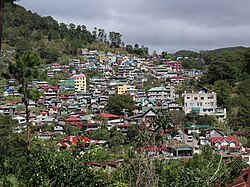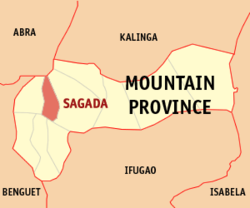
Back Sagada BCL Sagada CBK-ZAM Sagada CEB Sagada German Sagada Spanish Sagada French Sagada ID Sagada ILO Sagada Italian საგადა Georgian
This article needs additional citations for verification. (December 2013) |
Sagada
Ganduyan | |
|---|---|
| Municipality of Sagada | |
 Sagada in 2022 | |
| Motto: Ipey as Nan Gawis | |
| Anthem: Sagada Hymn | |
 Map of Mountain Province with Sagada highlighted | |
Location within the Philippines | |
| Coordinates: 17°05′03″N 120°54′03″E / 17.0842°N 120.9008°E | |
| Country | Philippines |
| Region | Cordillera Administrative Region |
| Province | Mountain Province |
| District | Lone district |
| Barangays | 19 (see Barangays) |
| Government | |
| • Type | Sangguniang Bayan |
| • Mayor | Felicito O. Dula |
| • Vice Mayor | David T. Buyagan |
| • Representative | Maximo Y. Dalog Jr. |
| • Electorate | 8,435 voters (2022) |
| Area | |
| • Total | 83.32 km2 (32.17 sq mi) |
| Elevation | 1,472 m (4,829 ft) |
| Highest elevation | 2,374 m (7,789 ft) |
| Lowest elevation | 835 m (2,740 ft) |
| Population (2020 census)[3] | |
| • Total | 11,510 |
| • Density | 140/km2 (360/sq mi) |
| • Households | 2,798 |
| Economy | |
| • Income class | 5th municipal income class |
| • Poverty incidence | 19.75 |
| • Revenue | ₱ 85.91 million (2020) |
| • Assets | ₱ 152.7 million (2020) |
| • Expenditure | ₱ 81.94 million (2020) |
| • Liabilities | ₱ 35.42 million (2020) |
| Service provider | |
| • Electricity | Mountain Province Electric Cooperative (MOPRECO) |
| Time zone | UTC+8 (PST) |
| ZIP code | 2619 |
| PSGC | |
| IDD : area code | +63 (0)74 |
| Native languages | Bontoc Balangao Ilocano Tagalog Northern Kankanay |
| Major religions | Episcopal Church of the Philippines |
| Website | sagada |
Sagada, officially the Municipality of Sagada is a 5th class municipality in the province of Mountain Province, Philippines. According to the 2020 census, it has a population of 11,510 people.[3]
Sagada is 20 kilometres (12 mi) from the provincial capital Bontoc, 396 kilometres (246 mi) from Manila via Halsema Highway, and 146 kilometres (91 mi) from Baguio.
Sagada is famous for its hanging coffins. This is a traditional way of burying people that is still utilized. The elderly carve their own coffins out of hollowed logs. If they are too weak or ill, their families prepare their coffins instead. The dead are placed inside their coffins (sometimes breaking their bones in the process of fitting them in), and the coffins are brought to a cave for burial. The Sagada people have been practicing such burials for over 2,000 years, however, not everyone is qualified to be buried this way; among other things, one had to have been married and had grandchildren.
Popular activities include trekking, exploring both caves and waterfalls, spelunking, bonfires, picnics, rappelling, visiting historical sites, nature hikes, and participating in tribal celebrations. Guides can be found upon registration at the tourist-office in Sagada Proper (the main town) for a small fee. Most of the guides are natives, also known as Kankanaey.
- ^ Municipality of Sagada | (DILG)
- ^ "2015 Census of Population, Report No. 3 – Population, Land Area, and Population Density" (PDF). Philippine Statistics Authority. Quezon City, Philippines. August 2016. ISSN 0117-1453. Archived (PDF) from the original on May 25, 2021. Retrieved July 16, 2021.
- ^ a b Census of Population (2020). "Cordillera Administrative Region (CAR)". Total Population by Province, City, Municipality and Barangay. Philippine Statistics Authority. Retrieved 8 July 2021.
- ^ "PSA Releases the 2021 City and Municipal Level Poverty Estimates". Philippine Statistics Authority. 2 April 2024. Retrieved 28 April 2024.
© MMXXIII Rich X Search. We shall prevail. All rights reserved. Rich X Search



